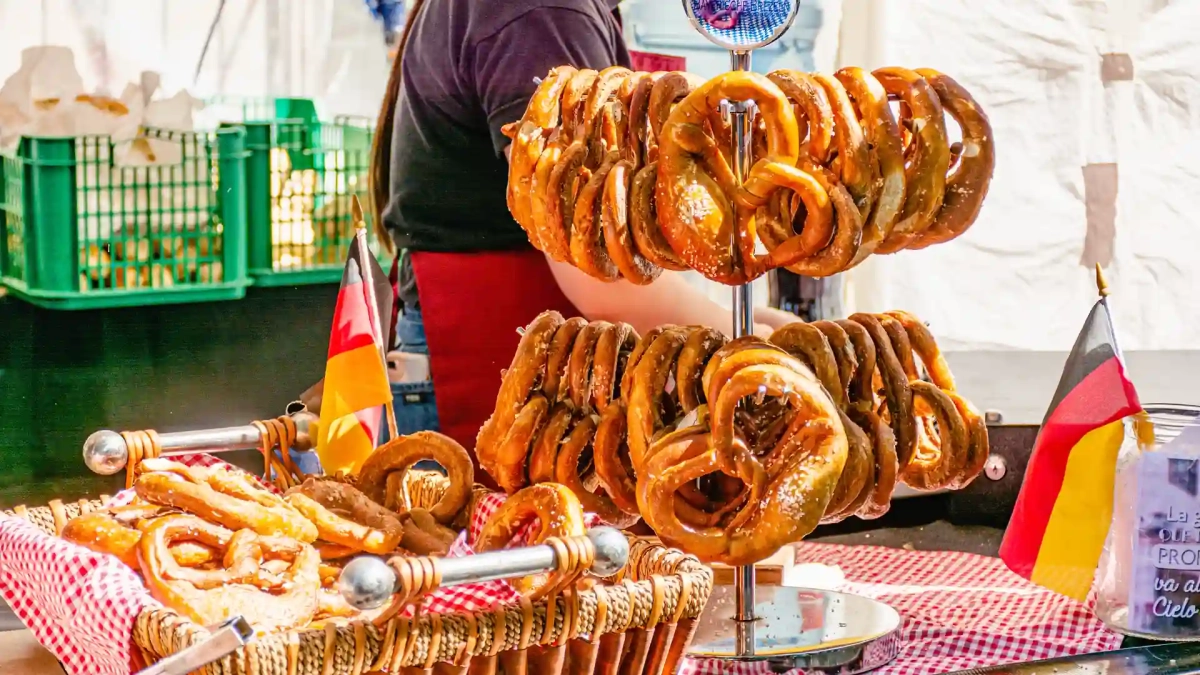German Street Foods: A Tasty Guide to Germany’s Best Street Foods and Prices
Germany is a country rich in food culture, and while it’s known worldwide for hearty dishes like bratwurst and pretzels, its vibrant street food scene is also worth exploring.
German street foods reflect the country’s blend of traditional flavors and global influences, providing an array of delicious, convenient, and budget-friendly options to locals and travelers alike.
Whether you’re in Berlin, Munich, or Cologne, street vendors across Germany offer treats that are as diverse as the regions themselves.
In this guide, we’ll take you through the best German street foods, approximate prices, and some tips to enjoy the local food scene to the fullest.
Classic German Street Foods You Must Try
From savory sausages to sweet treats, German street foods offer a variety of flavors that satisfy every craving. Here’s a closer look at some of the most popular options you’ll find throughout the country:
1. Currywurst
Currywurst is a quintessential German street food, especially popular in Berlin. This dish features a sliced, grilled pork sausage (usually bratwurst) smothered in a tangy curry ketchup sauce and dusted with curry powder. It’s often served with a side of Pommes (fries), making it a filling, flavorful meal on the go.
- Average Price: €4 – €5 for a standard portion with fries
- Best Places to Try: Currywurst is available in most cities, but try Curry 36 in Berlin for a particularly famous version.
2. Bratwurst
Bratwurst, a type of grilled sausage, is another must-try German street food. Made from pork, beef, or veal, bratwurst is seasoned with spices and herbs, giving it a robust flavor. It’s typically served in a roll with mustard and is a popular snack at fairs, markets, and street vendors throughout Germany.
- Average Price: €3 – €4
- Best Places to Try: Nuremberg is famous for its small Nuremberg bratwursts, which are often served three at a time in a roll.
3. Döner Kebab
The Döner kebab is one of Germany’s most popular street foods, introduced by Turkish immigrants in the 1970s and now a staple in almost every German city. It consists of seasoned meat (usually lamb, beef, or chicken) cooked on a vertical rotisserie, then sliced and served in flatbread with salad, tomatoes, onions, and sauces like garlic or spicy chili.
- Average Price: €4 – €6, depending on the size and toppings
- Best Places to Try: Berlin is renowned for its Döner kebabs, particularly Mustafa’s Gemüse Kebap, famous for its fresh ingredients.
4. Leberkäse
Leberkäse, or “liver cheese,” is a type of Bavarian meatloaf made from finely ground pork, beef, and sometimes liver, though modern versions often omit the liver. It’s usually served in a bread roll with mustard and makes for a hearty street snack.
- Average Price: €2.50 – €4 for a portion in a roll
- Best Places to Try: Leberkäse is especially popular in Bavaria, and you’ll find excellent versions at Munich’s Viktualienmarkt.
5. Fischbrötchen
A beloved street food in northern Germany, particularly in coastal cities like Hamburg, the Fischbrötchen is a sandwich featuring fresh fish (often herring, mackerel, or salmon) served in a roll with onions, pickles, and remoulade. It’s a tasty, seafood-focused street snack that captures Germany’s maritime flavors.
- Average Price: €3 – €5, depending on the type of fish
- Best Places to Try: Hamburg’s fish markets, such as the famous Fischmarkt, are great spots for fresh Fischbrötchen.
6. Brezel (Pretzel)
No list of German street foods would be complete without the Brezel or pretzel. This soft, chewy bread with a crisp outer crust is topped with coarse salt, making it a simple yet satisfying snack. Pretzels are sold everywhere from train stations to street corners, and their prices are as budget-friendly as the flavors are classic.
- Average Price: €1 – €2.50, depending on size and toppings
- Best Places to Try: Pretzels are widely available across Germany, but you’ll find some of the best in southern Germany, particularly in Bavaria.
7. Kartoffelpuffer (Potato Pancakes)
Kartoffelpuffer, or potato pancakes, are a popular street food during Christmas markets and local fairs. Made from grated potatoes, onions, and eggs, they’re pan-fried to a crispy golden brown. Kartoffelpuffer are typically served with apple sauce for a delightful sweet-savory experience.
- Average Price: €2 – €3 per pancake
- Best Places to Try: Christmas markets in cities like Cologne, Nuremberg, and Berlin are known for their delicious Kartoffelpuffer.
8. Pommes Frites (French Fries)
While French fries might not seem uniquely German, they’re an incredibly popular street food and are often enjoyed as a side with dishes like Currywurst or simply on their own. German street vendors typically offer a variety of toppings, from traditional ketchup and mayo to more adventurous flavors like curry or garlic sauce.
- Average Price: €2 – €3 for a small portion, €4 – €5 for a large portion
- Best Places to Try: Pommes frites are widely available, and you’ll find particularly good options at street food stalls in Berlin.
Sweet German Street Foods You Can’t Miss
Germany’s street food scene isn’t just about savory snacks. There are plenty of sweet treats that satisfy a sweet tooth, making street food tours even more exciting.
1. Berliner Pfannkuchen (Berliner Doughnut)
The Berliner is a popular German doughnut without a hole in the middle, filled with jam or custard and topped with powdered sugar or icing. It’s a favorite at festivals and street food markets, particularly during New Year celebrations and carnivals.
- Average Price: €1 – €2 per piece
- Best Places to Try: Bakeries and street vendors across Germany, especially in Berlin and other major cities.
2. Apfelstrudel (Apple Strudel)
Apfelstrudel is a warm, comforting pastry filled with spiced apples and raisins. While traditionally an Austrian dessert, it’s widely enjoyed in Germany and often served with a dusting of powdered sugar or a side of vanilla sauce.
- Average Price: €3 – €5 per slice
- Best Places to Try: Christmas markets and bakeries across Germany.
3. Gebrannte Mandeln (Candied Almonds)
Gebrannte Mandeln, or candied almonds, are a sweet treat that you’ll find at almost any German fair or Christmas market. These almonds are roasted in a sugar glaze until they’re caramelized and crunchy, creating a delicious snack with a warm, festive aroma.
- Average Price: €3 – €4 for a small bag
- Best Places to Try: Any German Christmas market is likely to have stalls selling freshly roasted Gebrannte Mandeln.
4. Kaiserschmarrn
Kaiserschmarrn is a fluffy shredded pancake, typically served with powdered sugar and a side of fruit compote, such as apple or plum. Originally from Austria, it’s a popular street food treat in southern Germany, particularly at Christmas markets.
- Average Price: €4 – €6 per portion
- Best Places to Try: Bavarian markets and food festivals, especially in Munich and Nuremberg.
5. Schokokuss (Chocolate Kiss)
Schokoküsse, or chocolate kisses, are soft marshmallow treats coated in chocolate. They come in various flavors and toppings, making them a delightful and inexpensive street snack, especially loved by children.
- Average Price: €0.50 – €1 each
- Best Places to Try: Fairs, carnivals, and markets throughout Germany.
Regional German Street Foods
Different regions in Germany have their own unique street food specialties, which reflect local ingredients and culinary traditions. Here are a few regional street foods you’ll want to try if you’re exploring various parts of the country:
1. Maultaschen (Swabian Dumplings)
In Swabia, Maultaschen are a beloved street food. These dumplings are filled with meat, spinach, and spices, often served in a broth or pan-fried. Sometimes referred to as “Swabian ravioli,” they’re both filling and delicious.
- Average Price: €3 – €4 per portion
- Best Places to Try: Swabian regions, particularly Stuttgart and the surrounding areas.
2. Rheinischer Sauerbraten Sandwich
This sandwich version of the classic Sauerbraten is popular in the Rhineland region. It’s made with marinated beef or pork, served on a crusty roll with mustard or horseradish. This unique twist on a traditional German dish makes for a tasty and convenient street food.
- Average Price: €4 – €6
- Best Places to Try: Cologne and Düsseldorf
3. Zwiebelkuchen (Onion Tart)
Popular in the southwestern regions of Germany, particularly during wine festivals, Zwiebelkuchen, or onion tart, is a savory street food made with onions, bacon, and a rich, creamy filling, all baked on a thin crust. It pairs beautifully with a glass of local white wine, especially during the fall wine harvest season. Zwiebelkuchen is a beloved treat at street festivals, fairs, and markets in southwestern Germany.
- Average Price: €3 – €4 per slice
- Best Places to Try: Wine festivals and markets in Baden-Württemberg and the Rhineland-Palatinate regions
Street Food Markets in Germany
Germany’s street food culture has grown tremendously, and now, dedicated street food markets and festivals are common in many cities. These events bring together food trucks, local vendors, and international cuisine, offering a unique chance to sample a wide range of flavors. Here are some popular markets and festivals where you can try German street foods and much more:
1. Markthalle Neun, Berlin
Located in the heart of Berlin’s Kreuzberg district, Markthalle Neun is one of the best-known food markets in Germany. It hosts a Street Food Thursday event every week, featuring a blend of traditional German snacks, international foods, and innovative dishes created by local chefs. Here, you’ll find everything from classic bratwurst to experimental fusion foods.
- Popular Street Foods: Currywurst, Döner kebab, Kartoffelpuffer
- Average Price: Most dishes range from €4 – €8
2. Viktualienmarkt, Munich
The Viktualienmarkt in Munich is a historical market with vendors offering a range of fresh produce, meats, cheeses, and prepared foods. While it’s open daily, it has a lively street food scene, especially during Oktoberfest and other local celebrations. You’ll find traditional Bavarian street foods as well as modern takes on German classics.
- Popular Street Foods: Leberkäse, Brezels, Weisswurst
- Average Price: Most items range from €3 – €6
3. Fischmarkt, Hamburg
Hamburg’s Fischmarkt is a famous weekly market held on Sunday mornings along the Elbe River. It’s known for its seafood street foods, particularly Fischbrötchen and other fresh fish-based snacks. The early morning vibe, lively crowds, and fresh seafood make it a memorable experience.
- Popular Street Foods: Fischbrötchen, smoked fish, herring sandwiches
- Average Price: Most fish-based items range from €3 – €7
4. Stuttgart Street Food Market
Stuttgart hosts several street food markets throughout the year, bringing a fusion of local Swabian foods and international options. This market is known for its family-friendly atmosphere, offering everything from Maultaschen to global street foods, making it a favorite destination for food lovers.
- Popular Street Foods: Maultaschen, Käsespätzle (cheesy pasta), international dishes
- Average Price: Most items range from €4 – €9
Tips for Enjoying German Street Foods
If you’re planning to dive into the world of German street foods, here are a few tips to enhance your experience:
- Bring Cash: Although more places are accepting card payments, many small vendors and street stalls in Germany still prefer cash. It’s always a good idea to carry some euros with you when exploring street food markets.
- Embrace Local Specialties: Each region has its own culinary gems, so be sure to try regional specialties when traveling around Germany. From Swabian Maultaschen to Berlin’s Currywurst, each local dish offers unique flavors and history.
- Visit During Festivals: Many German cities hold food festivals and markets during the year, especially around Christmas or regional harvest celebrations. These events are perfect for sampling seasonal street foods like Gebrannte Mandeln or Kartoffelpuffer.
- Get Comfortable with Standing: In true street food fashion, many vendors provide only small tables or standing counters for customers. Embrace the casual vibe, stand alongside locals, and enjoy your food on the go.
- Try New Toppings and Sauces: Many German street foods, like Döner kebabs and Pommes, come with a variety of toppings and sauces to choose from. Don’t hesitate to experiment with different flavors, from spicy chili sauce to herb-infused garlic sauce.
- Save Room for Sweets: German street food isn’t just about savory snacks. Leave some room for a Berliner doughnut, Gebrannte Mandeln, or a slice of Apfelstrudel to finish off your culinary adventure on a sweet note.
Why German Street Foods Are Worth Exploring
German street foods are a wonderful way to experience the country’s culinary heritage, with a unique mix of traditional flavors, regional specialties, and multicultural influences. From the delicious spice of a Currywurst to the comforting bite of a fresh Brezel, German street foods offer something for every taste and budget. Not only are these foods affordable, but they also provide an authentic insight into Germany’s rich and evolving food culture.
Whether you’re enjoying a Fischbrötchen along Hamburg’s port or biting into a warm Leberkäse roll in Munich, street foods allow you to immerse yourself in the heart of German society. Each dish tells a story—of history, of local pride, and of a shared passion for good food. So the next time you’re in Germany, skip the sit-down restaurants for a day and savor the incredible world of German street foods
How informative was this article?
Click on a star to rate it!
We are sorry that this post was not useful for you!
Let us improve this post!
What is missing in the article?















